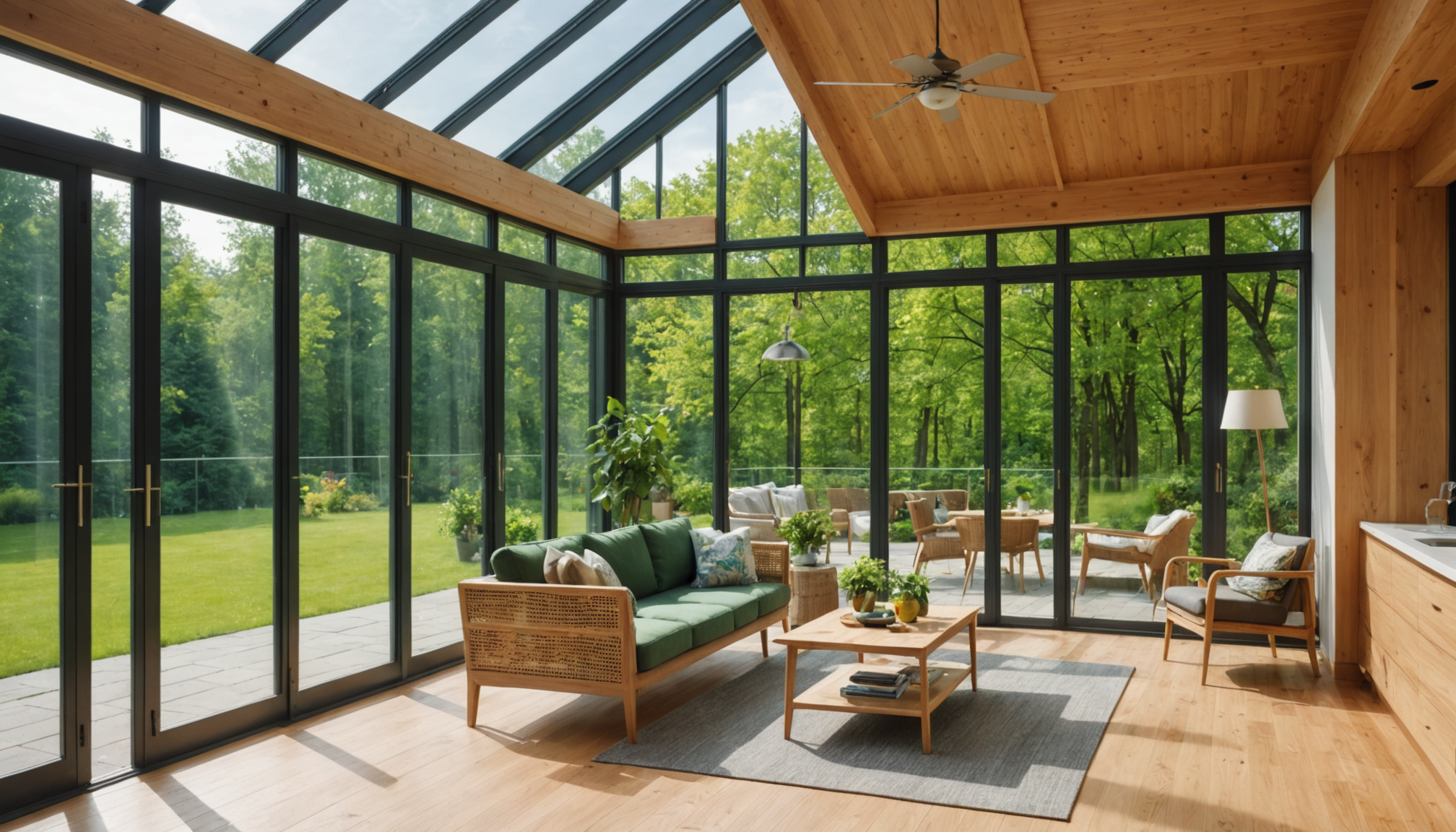One of the most critical steps in remodeling your sunroom is selecting the appropriate materials. This step not only influences the aesthetic appeal of the space but also impacts its durability, energy efficiency, and overall functionality. As you embark on this exciting project, it is essential to assess materials that will withstand various weather conditions while maintaining eco-friendly properties.
When choosing materials for your sunroom, consider those that provide effective insulation. Proper insulation is vital for regulating temperature and improving energy savings throughout the year. High-performance, insulated glass is an excellent option for windows, as it reduces heat transfer and lessens the load on your HVAC system. Double or triple-glazed windows with low-emissivity coatings can significantly enhance the energy efficiency of your sunroom.
For those who prioritize an eco-friendly approach, sustainable materials should be a top consideration. Opt for recycled or reclaimed materials such as wood, metal, or composite decking for flooring and wall applications. These materials reduce the depletion of natural resources and can offer a unique, rustic appearance. Fortunately, many manufacturers offer attractive options that do not compromise style or quality.
| Material | Benefits | Considerations |
| Insulated Glass | Energy-efficient, reduces heat transfer | Higher upfront cost |
| Reclaimed Wood | Eco-friendly, unique texture | Possible variations in quality |
| Composite Decking | Durable, low maintenance | Can be more expensive |
| Metal Roofing | Durable, reflectivity enhances energy efficiency | May require soundproofing |
Another essential aspect of material selection is ensuring that all elements are suitable for both indoor and outdoor environments, emphasizing resilience and adaptability. Metal roofing, for example, is a durable option that reflects sunlight, reducing heat buildup and providing energy savings. Just be mindful that metal can be louder during rainstorms, so consider adding soundproofing insulation to alleviate any potential noise issues.
The choice of materials when remodeling a sunroom can greatly affect comfort, efficiency, and sustainability. By considering factors such as insulation, eco-friendliness, and adaptability to varying environmental conditions, you can create a sunroom that not only enhances your home but also aligns with broader environmental goals. Each material brings its own set of advantages and considerations, so it’s crucial to weigh these carefully to ensure your sunroom remodel is a lasting success.
Maximizing natural light
To fully take advantage of your sunroom, it’s crucial to maximize natural light, transforming the space into a bright and inviting retreat. Achieving this involves making smart design choices that allow sunlight to flood the room while simultaneously considering energy efficiency and comfort.
- Optimize Window Placement: Begin by evaluating the current placement and size of windows in your sunroom. Ideally, large windows should be positioned to capture sunlight throughout the day. South-facing orientations often provide the most consistent light, helping in reducing your need for artificial lighting and contributing to energy savings.
- Choose the Right Glass: Installing high-quality glass can make a significant impact. Opt for large, floor-to-ceiling glass panels or sliding doors that open up views and allow ample sunlight in. Low-emissivity (Low-E) glass is an excellent choice as it minimizes glare and improves insulation, helping to regulate temperature while maximizing light.
- Add Skylights: If your sunroom structure allows, consider adding skylights. These can dramatically increase the amount of sunlight entering the space, creating a warm and natural ambiance. Ensure that skylights have appropriate shading or tints to prevent overheating and include seals to maintain energy efficiency.
- Use Reflective Surfaces: Incorporate surfaces that reflect light, such as mirrors or glossy finishes. Position mirrors across from windows to double the amount of natural light in your room, creating an illusion of a larger, more open space. Reflective flooring and light-colored walls can also help bounce sunlight throughout the room.
- Implement Adjustable Shades: While natural light is wonderful, there are times when it can be too intense or create uncomfortable glare. Installing adjustable shades, blinds, or curtains allow you to control the amount of light entering the room. Opt for options that are easy to manage and made from lightweight, eco-friendly materials.
- Landscaping Considerations: Surrounding plant life and trees can both aid and hinder light entry. Pruning overgrown trees or selecting lower-growing species can prevent obstructions. Strategically placed foliage can also provide natural shading, cooling the area during peak sun hours while letting sunlight pour in during other times.
- Maintain Clean Windows: Regular maintenance and cleaning of windows ensure they allow maximum light penetration. Accumulated dirt and grime can block sunlight; thus, periodic cleaning is key to sustaining the natural brightness of your sunroom.
By focusing on these strategies during your remodel, you can enhance natural light while maintaining an eco-friendly and energy-efficient sunroom. The end result will not only save on energy costs but also create a brighter, more uplifting environment for relaxing and entertaining.
Incorporating energy-efficient solutions
To enhance your sunroom’s efficiency, integrating energy-efficient solutions is not only wise for reducing energy consumption but also beneficial for the environment. One vital approach is incorporating advanced insulation technology. High-quality insulation prevents heat escape during colder months while keeping the cool air inside during summer. This helps maintain a comfortable temperature in your sunroom year-round, ultimately leading to significant energy savings.
Investing in energy-efficient windows is pivotal. Consider installing double or triple-glazed panes, which provide superior insulation and noise reduction. These windows, often treated with low-emissivity (Low-E) coatings, minimize infrared and ultraviolet light passage without reducing the amount of light entering your sunroom. This not only preserves your energy resources but also protects your interior furnishings from harmful sun exposure.
Another important feature is the consideration of solar shades or blinds. These elements provide flexible, breathable insulation, reflecting heat away during sweltering afternoons yet allowing sunlight to warm the space when needed. They give you control over your sunroom’s lighting and temperature, adapting to different weather conditions efficiently.
For those who are eco-conscious, adopting renewable energy solutions, like solar paneling, can significantly offset energy costs. By harnessing clean energy to power your sunroom, you contribute positively to the environment while enjoying modern comforts. Smart home technology, such as programmable thermostats or smart blinds, further enhances energy efficiency. These systems optimize resource use by adjusting settings based on the time of day or room occupancy, ensuring reduced waste and optimized comfort.
In addition, choose eco-friendly building materials whenever possible. These materials not only reduce carbon footprint but often come with better insulating properties, aiding your overall energy efficiency. Opt for non-toxic paints and finishes, which add an extra layer of protection to your home’s environment, promoting healthier air quality.
Furthermore, consider integrating energy-efficient lighting options. LED or CFL bulbs offer longer lifespans and lower energy consumption, reducing both your electric bill and energy footprint. When natural light is not an option, these lighting solutions provide effective illumination without compromising on efficiency.
By incorporating these energy-efficient strategies into your sunroom remodel, you’ll create a space that is not just sustainable and comfortable but also aligned with modern energy-saving practices. This thoughtful integration will ensure your sunroom remains a welcoming haven that respects both your financial responsibilities and environmental responsibilities.
Selecting furnishings and decor
When selecting furnishings and decor for your sunroom remodel, it’s essential to blend functionality with style, creating a cozy and inviting atmosphere that encourages relaxation while optimizing the space’s aesthetics and utility. Begin by considering the function of your sunroom: is it a tranquil reading nook, a vibrant entertainment area, or a multifunctional family space? Defining its purpose will guide your choices in furnishings and decor.
Opt for furniture that is both comfortable and resilient, designed to withstand fluctuating temperatures and sunlight exposure common in sunrooms. Materials such as teak, wicker, rattan, and powder-coated metal are popular choices for their durability and eco-friendly properties. Select cushions and upholstery fabrics that are fade-resistant and easy to clean, ensuring longevity and maintaining a fresh appearance despite prolonged sun exposure. Consider pieces with built-in storage options, such as ottomans or benches, which can keep the space organized while maximizing utility.
To further enhance the ambiance, thoughtfully curate the decor by incorporating elements that reflect your personal style and complement the natural beauty of the sunroom. Use neutral, light-toned color palettes to evoke an airy and expansive feel, and add pops of color through accessories like throw pillows, rugs, or artwork. Introduce natural materials and textures, such as bamboo blinds or sisal rugs, to reinforce a seamless connection with the outdoors, enhancing the eco-friendly vibe you desire in a sunroom.
Lighting also plays a crucial role in creating a versatile and welcoming environment. Besides maximizing natural light, consider incorporating a mix of task and ambient lighting to suit different times of the day and activities. Floor lamps, pendant lights, and LED strips can provide practical and energy-efficient illumination, adding a warm glow to your sunroom during evenings or cloudy days.
Plants are another excellent addition, bringing vibrancy and life into the space while improving air quality. Choose low-maintenance varieties such as ferns, succulents, or peace lilies, which thrive in filtered sunlight and add a touch of greenery without requiring extensive care.
Incorporating mirrors can help to reflect sunlight, making the space feel larger and brighter. Position them strategically to bounce light around the room and capitalize on the natural light pouring through the windows.
Finally, ensure a good flow and layout, allowing easy movement and access to outdoor views. Arrange furniture in a way that encourages conversation and interaction, and maintain open sightlines to the outside, blurring the boundary between indoor and outdoor spaces.
In summary, by thoughtfully choosing furnishings and decor, you can create a sunroom that serves as a functional, beautiful oasis that feels like a natural extension of your home, maximizing both comfort and energy savings in an eco-friendly yet stylish manner.
Creating a seamless indoor-outdoor transition
Creating a seamless connection between your sunroom and the outdoors enhances the overall flow and utility of your home, making the sunroom feel like a natural extension of your living space. To achieve this, consider integrating large, retractable glass doors or bi-fold doors. These doors can completely open up the sunroom to the outside, providing an unobstructed view and facilitating easy access to your garden or patio area. When closed, they maintain excellent insulation, protecting the interior from temperature fluctuations while still allowing abundant natural light to flood the space.
Incorporating flooring that continues from the interior of the sunroom to the outdoors can also create a visual and textural connection. Choose durable materials, such as stone, tile, or weather-resistant composite decking, that can withstand the elements while maintaining a cohesive look. Matching or harmonizing indoor and outdoor furniture styles will further blur the boundaries; consider using similar or complementary colors and materials like teak or weatherproof wicker.
To ensure an eco-friendly approach, select energy-efficient, sustainable building materials for both the sunroom and surrounding outdoor areas. Using regionally-sourced wood or recycled materials not only supports local economies but also reduces the environmental impact of your remodel.
Landscaping plays a key role in the seamless transition as well. Strategically plant low-height greenery or use potted plants to define the boundaries gently, creating inviting outdoor living areas that encourage movement between spaces. Vegetative pathways and natural stone steps can guide your family’s journey from one zone to another, enhancing interaction with the environment around your home.
Consider the use of lighting to extend the functionality of both indoor and outdoor areas into the evening hours. Installing solar-powered garden lights or LED sconces along pathways and around seating areas increases safety and enhances ambiance without substantially increasing energy consumption. These additions will ensure your sunroom remains a comfortable and usable space regardless of the time of day.
Finally, achieve a harmonious design by carrying color palettes and decorative themes from the interior spaces outwards. Using textiles and accessories that are coordinated with your home’s style will ensure that, even when the doors are closed, the indoor and outdoor aesthetics feel cohesive and balanced.
In conclusion, remodeling your sunroom offers an exciting opportunity to create a versatile, energy-efficient space that bridges the indoor and outdoor realms. By carefully selecting materials, maximizing natural light, adopting eco-friendly technologies, and thoughtfully choosing furnishings, you can design a sunroom that enhances both comfort and sustainability. This harmonious integration of aesthetics and functionality will not only elevate your home’s value but also enrich your living experience for years to come.


